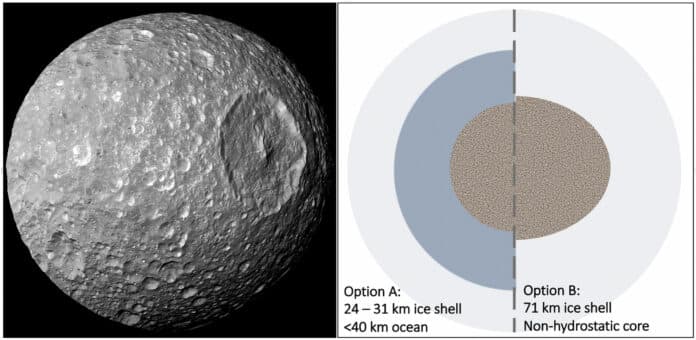Mimas, a small moon of Saturn, is heavily cratered and lacks the typical characteristics of an ocean-bearing moon.
Colleagues started examining Mimas’ surface to comprehend how its interior may have evolved after a Southwest Research Institute scientist found stunning evidence that Saturn’s tiniest, the innermost moon, may generate enough heat to maintain an internal liquid ocean.
The structure of Mimas’ Herschel impact basin, the most notable feature of its severely cratered surface, and the absence of tectonics are consistent with a thinning ice shell and a geologically young ocean, according to numerical simulations of the moon.
SwRI’s Dr. Alyssa Rhoden, a specialist in the geophysics of icy satellites, said, “In the waning days of NASA’s Cassini mission to Saturn, the spacecraft identified a curious libration, or oscillation, in Mimas’ rotation, which often points to a geologically active body able to support an internal ocean.”
“Mimas seemed like an unlikely candidate, with its icy, heavily cratered surface marked by one giant impact crater that makes the small moon look much like the Death Star from Star Wars. If Mimas has an ocean, it represents a new class of small, ‘stealth’ ocean worlds with surfaces that do not betray the ocean’s existence.”
Rhoden collaborated with doctoral student Adeene Denton from Purdue to better understand how a moon with as many craters as Mimas could have an interior ocean. Denton used the simulation programme iSALE-2D to model the creation of the Hershel impact basin.
According to the models, Mimas’ ice shell had to have been at least 34 miles (55 km) thick at the time of the impact that created Herschel. On the other hand, if Mimas is still home to an ocean, observations of the planet and simulations of its internal heating limit the thickness of its present-day ice shell to less than 19 miles (30 km).
Denton, who is now a postdoctoral researcher at the University of Arizona, said, “We found that Herschel could not have formed in an ice shell at the present-day thickness without obliterating the ice shell at the impact site. If Mimas has an ocean today, the ice shell has been thinning since the formation of Herschel, which could also explain the lack of fractures on Mimas.”
“If Mimas is an emerging ocean world, that places important constraints on the formation, evolution, and habitability of all of the mid-sized moons of Saturn.”
Rhoden said, “Although our results support a present-day ocean within Mimas, it is challenging to reconcile the moon’s orbital and geologic characteristics with our current understanding of its thermal-orbital evolution.”
“Evaluating Mimas’ status as an ocean moon would benchmark its formation and evolution models. This would help us better understand Saturn’s rings and mid-sized moons and the prevalence of potentially habitable ocean moons, particularly at Uranus. Mimas is a tempting target for continued investigation.”
Journal Reference:
- C. A. Denton, A. R. Rhoden. Tracking the Evolution of an Ocean Within Mimas Using the Herschel Impact Basin. Geophysical Research Letters. DOI: 10.1029/2022GL100516
